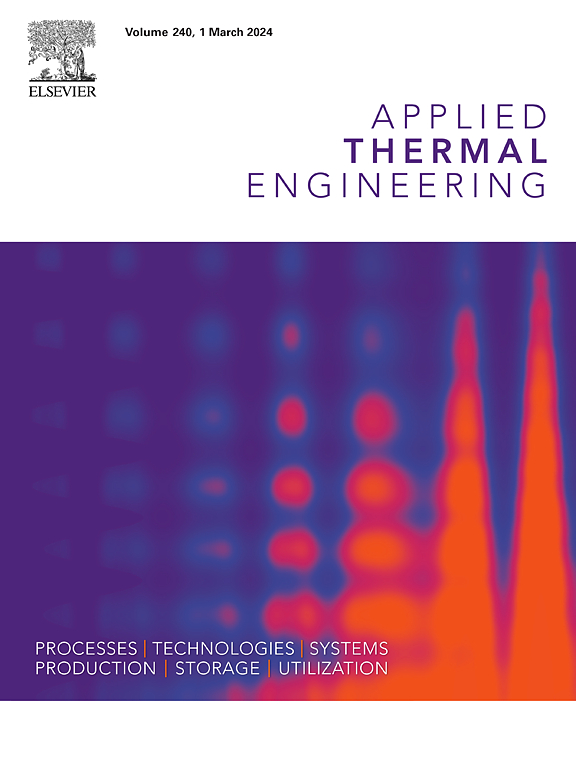探索宾厄姆流体流动中的共轭传热:结合双扩散和Papanastasiou模型的三维计算方法
IF 6.1
2区 工程技术
Q2 ENERGY & FUELS
引用次数: 0
摘要
本研究采用双扩散和共轭传热的方法,考察了热质传递对发光二极管(LED)等多种电子器件性能和耐用性的影响因素。利用Papanastasiou模型对Bingham流体的非线性流变学进行了研究,该模型用于控制屈服应力不连续。一个带有平板翅片的实心垂直板被认为在外部加热,起到LED底板的作用。一组非线性微分方程模拟了这种物理现象。有限元格式是一种很有前途的计算工具,它首先通过实验和数值数据进行了验证。计算模型的优化表明,三维(3D)结果描绘了最好的结构可视化,但成本比二维(2D)高得多。非牛顿行为表明,热通量和质量通量随屈服数(yt)的减小而减小,在牛顿材料的情况下达到最大值。热传递随导热系数Rk和板厚xp的增加而增加。瑞利数(Ra)的增加增加了剪切速率,翅片附近的未屈服区减小,导致对流增强。注意到Soret (Sr)和Dufour (Df)参数对传热传质速率有正影响。结果表明:质量流率随路易斯数(Le)的增大而增大,而传热率则相反。Ha的影响表明,在没有磁场的情况下,传热和传质速率最大。平均努塞尔数(Nuavg)的相对变化在开始时较低,随着Ha的增加而增加,在Ha = 60时最大。本文章由计算机程序翻译,如有差异,请以英文原文为准。

Exploring conjugate heat transfer in Bingham fluid flow: A 3D computational approach incorporating double diffusion and the Papanastasiou model
In this study, double diffusion and conjugate heat transfer are adopted to examine the factors affecting the heat and mass transfer on the performance and durability of many electronic devices such as light-emitting diode (LED). The non-linear rheology of Bingham fluid, utilizing the Papanastasiou model to manage yield stress discontinuities, is investigated inside a cubical enclosure. A solid vertical plate with slab fins is considered to be heated externally, playing the role of an LED base plate. A collection of non-linear differential equations simulates the physical phenomenon. A promising tool, the finite element scheme is utilized for computations which is first validated with experimental and numerical data. Optimization of computational cast reveals that three-dimensional (3D) result depicts the best structural visualization but it is much more costly than two-dimensional (2D). The non-Newtonian behaviour shows that heat and mass fluxes decrease with yield number (yt) and the maximum is obtained in the case of Newtonian materials. The thermal energy transport increases with both thermal conductivity ratio (Rk) and plate thickness (xp). Increasing the Rayleigh number (Ra) increases the shear rate and unyielded region diminishes near the fins, leading to promoted convection. It is noticed that Soret (Sr) and Dufour (Df) parameters have positive impacts on heat and mass transfer rates. Results show that mass flow rate rises with Lewis number (Le) while the opposite trend is seen in heat transmission. The influence of Ha reveals that heat and mass transfer rates are maximum in the absence of magnetic fields. The relative change of mean Nusselt number (Nuavg) is low at the beginning and rises with Ha, attens the maximum decrease at Ha = 60.
求助全文
通过发布文献求助,成功后即可免费获取论文全文。
去求助
来源期刊

Applied Thermal Engineering
工程技术-工程:机械
CiteScore
11.30
自引率
15.60%
发文量
1474
审稿时长
57 days
期刊介绍:
Applied Thermal Engineering disseminates novel research related to the design, development and demonstration of components, devices, equipment, technologies and systems involving thermal processes for the production, storage, utilization and conservation of energy, with a focus on engineering application.
The journal publishes high-quality and high-impact Original Research Articles, Review Articles, Short Communications and Letters to the Editor on cutting-edge innovations in research, and recent advances or issues of interest to the thermal engineering community.
 求助内容:
求助内容: 应助结果提醒方式:
应助结果提醒方式:


